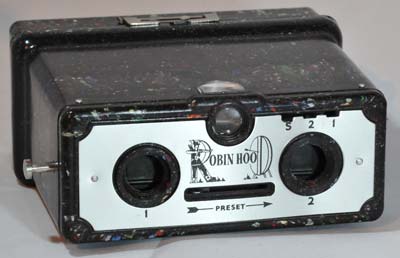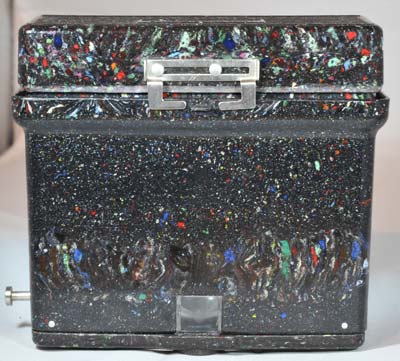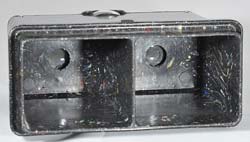Standard Robin Hood Stereo
Specification


| Manufacturer | : | Standard |
|---|---|---|
| Produced | : | 1930s |
| Classification | : | Medium Format |
| Body Type | : | Solid Body Stereo |
| Construction | : | Bakelite |
| Film Type | : | Sheet Safety Film |
| Film Size | : | 4¼" x 1¾" |
| Image Size | : | 2" x 1⅝" (5.3 x 4.3 cm) |
| No. of Images | : | 1 stereo or 2 single. |
| Lens Type | : | 2 x Meniscus |
| Focal Length | : | 75mm |
| Focus Type | : | fixed |
| Focal Range | : | 9ft - Inf. |
| Aperture Type | : | Fixed |
| Apertures | : | f/16 |
| Shutter Type | : | Fixed Speed |
| Shutter Speeds | : | I*(1/80s) |
| Size (w x h x d) | : | 115 x 55 x 100 mm |
| Weight | : | 244g |
| * Measured on this camera | ||
Art Deco Credentials
![]()
![]()
![]()
![]()
Significant: Pronounced and self evident
- Produced during the main Art Deco period.
- Bakelite body multi-coloured speckling.
- Curvilinear body design.
- Alloy plate face.
- Art Deco style name graphic on faceplate
- Chromed shutter release
- Bright metal back latch
Description

The Robin Hood is a stereo camera that was made in the 1930s by Standard Cameras Ltd. of Birmingham, England. It was an inexpensive Bakelite camera that was black with speckles of colour in the finish. It has a decorative metal face plate with a Robin Hood logo. It uses single sheets of film and could take 2 single shots or a stereo pair.
When it came out, it was original and unique. Never before had a camera been offered which took both ordinary and stereoscopic pictures. It was sold with the option of buying a Developing and Printing Outfit. Advertising material at the time suggested that "Even if you bought the World's most expensive camera, you would use similar chemicals to those provided with this outfit and you would go about the matter in the same way." This camera was attractive to budding young scientists and engineers.
Getting images by following every step of the 14 page, small print user manual must have been quite a challenge. Another challenge was that this camera had to be loaded in the dark.

The camera has two fixed focus meniscus lenses mounted in separate compartments. Sheet film is loaded into the back of the camera in the dark. It has a single-blade spring powered guillotine single speed shutter. A selector on the front allows you to choose to expose frame 1 and frame 2 separately or both simultaneously to produce a stereo image pair. The shutter must be primed by sliding a lever on the face of the camera. The shutter is released using a plunger on the side of the camera. You must then unload the film and reload the camera with another sheet of film in the dark.
It has an integrated waist level bright viewfinder at the front.
Developing and printing your film
The Developing and Printing Outfit must be bought separately and contains developing chemicals, fixing salts, printing paper and a wire printing frame. The back of the camera is used as a printing guide and recepticle for the fluids. A contact print is made from the negative by using electric light or gas light for 5 or 6 seconds. The print is developed in a similar way to the negative using developer and fixing salts.

Viewing your stereo images
Stereo images can be viewed using a 3-D viewer. Before viewing the two images must be separated and reversed. As it says on the box, "if you have never before taken stereoscopic pictures you will be amazed at the startling reality achieved, which is almost impossible to describe."
How to Use
The User Manual is found here:- Robin Hood Manual.
This camera takes Sheet Film which is not currently available. You can cut your own film sheets from any 120 film - with difficulty.
With a shutter speed of only 1/80 sec, make sure you brace the camera against your body and press the shutter smoothly to avoid camera shake.
If you don't want to bother with an exposure meter, follow the guide shown. It is based on the 'Sunny 16' rule. Film is so forgiving and will produce acceptable results even when over-exposed by 2 or 3 stops or under-exposed by 1 stop.
The table shown assumes the shutter speed is about 1/80s.
The table also assumes that the sun is at least 30 degrees above the horizon - that's 10am - 5pm on a summers day in the UK.
Remember that the exposure guide in the manual may not be helpful as it is based on the use of old film with a low ISO value.
So, you need a nice sunny day for this camera and a lot of patience.
Using ISO 100/125 film - shutter speed 1/80s
| Weather Conditions | Shadow Detail | Aperture | Exposure |
|---|---|---|---|
 Sunny SunnySnow/Sand | Dark with sharp edges | f/16 | +1 Stop Overexposed Acceptable |
 Sunny Sunny | Distinct | f/16 | Good |
 Slight Overcast Slight Overcast | Soft around edges | f/16 | -1 Stop Underexposed Acceptable |
 Overcast Overcast | Barely visible | f/16 | -2 Stops Underexposed Not Acceptable |
 Heavy Overcast Heavy Overcast | None | f/16 | -3 Stops Underexposed Not Acceptable |
 Open Shade Open Shade/Sunset | None | f/16 | -4 Stops Underexposed Not Acceptable |